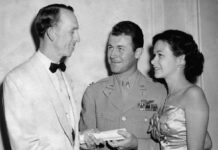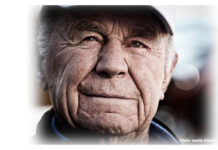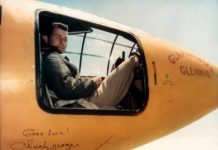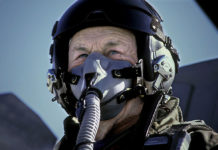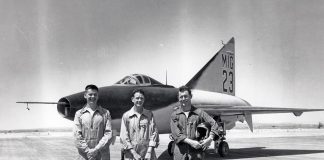On May 18, 1953, Jacqueline Cochran became the first woman to fly faster than the speed of sound and, at the time of her death in 1980, she held more speed, altitude, and distance records than any other male or female pilot in aviation history. Included in these are the eight world speed, altitude and distance records she set in 1961 in the Northrop T-38 Talon now in the Museum’s collection.
Cochran grew up in DeFuniak Springs, Florida and always lived life on her own terms. At 10 years old she left her job in the cotton mills for a live-in position at a beauty salon, and later briefly studied nursing. Determined to succeed, Cochran left the Florida panhandle but returned to hairdressing and, by the early 1930s, worked her way up to the fashionable Antoine’s salons in Saks Fifth Avenue stores in New York City and Miami. Throughout her public adult life, Cochran, born Bessie Mae Pittman, maintained she was an orphan while privately staying in contact with the Pittman family.
When contemplating starting her own business she learned to fly at the suggestion of her future husband Floyd Odlum, founder and president of the Atlas Corporation, to market the venture. In 1932, she soloed at Roosevelt Flying School on Long Island and received her license after only three weeks of lessons; she then immediately pursued advanced instruction at the Ryan School of Aeronautics and built up flight time. She earned her instrument rating and commercial and transport pilot licenses and entered the 1934 MacRobertson Air Race from London, England to Melbourne, Australia flying a Granville R-6H QED, only to be forced down by mechanical difficulty in Bucharest, Romania.
In 1935 she established Jacqueline Cochran Cosmetics, Wings of Beauty, in Chicago, Los Angeles, and eventually on New York’s Fifth Avenue, successfully competing with Helena Rubenstein and Elizabeth Arden beauty houses. Cochran flew around the country delivering test products and building up distributors, and she formulated a moisturizer to combat dry skin resulting from high altitude flight. After a flight, Cochran always took time to repair her makeup and comb her hair as a personal preference but also cognizant of the public view of women pilots as non-feminine. But first and foremost, Cochran was an ambitious record setter. She set two women’s speed records in her Beech D-17W Staggerwing in 1937, followed by three major (men’s and women’s) flying records and, after three attempts, she won the prestigious 1938 Bendix Trophy Race flying Alexander de Seversky’s P-35 pursuit plane.
As war in Europe approached, Cochran was one of several women who felt women should be utilized in wartime aviation. In 1941, Cochran selected a group of 27 highly qualified U.S. women pilots to ferry military aircraft in Great Britain for the Air Transport Auxiliary (ATA), as most male military pilots were flying in combat. In 1942, Cochran, at the request of Army General Henry “Hap” Arnold, organized the Women’s Flying Training Detachment (WFTD) to train civilian women pilots in anticipation of a similar domestic shortage of American military pilots during World War II. Based first at Houston and then Avenger Field in Sweetwater, Texas, the WFTD received primary flight training in military aircraft from military instructors. The WFTD soon merged with Nancy Love’s Women’s Auxiliary Ferry Squadron (WAFS, a group of experienced pilots) to form the civilian Women Airforce Service Pilots (WASP) with Cochran as director. From 1943 to 1944, 1,074 women flew over 60 million miles ferrying aircraft and personnel, towing targets, and other transport duties. The WASP flew every military aircraft including Boeing B-17 and B-29 bombers. The WASP were disbanded in 1944, and Cochran was at the center of complications that prevented the group from being absorbed into the USAAF’s Women’s Army Auxiliary Corps (WAAC). The WASP finally received retroactive military status in 1977.
Following the war, Cochran earned more speed records including multiple ones in her Lockheed Lodestar. In 1953, she borrowed a Canadair F-86 Sabre jet (because military aircraft were not available to civilian and especially female pilots) to break the sound barrier; she was coached by Major Charles “Chuck” Yeager, the first man to break the sound barrier. For several years Cochran traded records with French pilot Jacqueline Auriol, a matter of pride for both nations. In 1961, she received permission to fly a company-owned Northrop T-38 Talon and promptly set straightaway courses, speed over various distance closed courses, and altitude records, including an absolute altitude record of 56,071.80 feet that bested Auriol’s. In May 1964, now allowed to fly a USAF Lockheed F-104 Starfighter, she became the first woman to fly Mach 2, twice the speed of sound. Cochran supported the Lovelace Clinic’s Women in Space Program that, in 1960-61, offered medical testing, exactly like the NASA tests given to prospective male astronauts, to highly-qualified female pilots; 13 women passed these initial tests but it ended there as NASA was not ready to allow women in the space program. A complex woman, Cochran recognized that fact but later held an ambivalent attitude of women as prospective astronauts or commercial airline pilots. Cochran was a two-time president of the women’s flying organization the Ninety-Nines (her good friend Amelia Earhart was a founding member) and the first female president of the Fédération Aéronatique Nationale (FAI, the official keeper of aviation records). She was a 14-time winner of the Harmon Trophy, awarded to the best female pilot of the year. She received the Distinguished Service Medal for her leadership of the WASP and three Distinguished Flying Cross awards for other records. She was also a Colonel in the U.S. Air Force Reserve. Cochran authored two autobiographies —The Stars at Noon and, with Mary Ann Bucknam Brinley, Jackie Cochran.
(information compiled by D. Cochrane and P. Ramirez)
Source: https://airandspace.si.edu/explore-and-learn/topics/women-in-aviation/cochran.cfm


